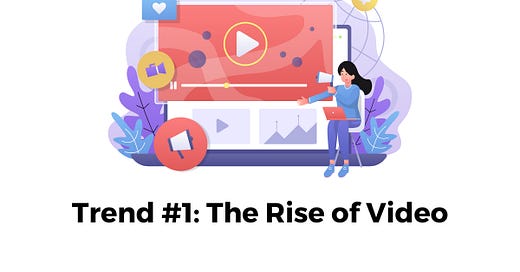LinkedIn is the world's largest professional networking platform, with over 800 million members. It's a powerful tool for businesses of all sizes to reach their target audience, generate leads, and close deals. But the landscape of LinkedIn marketing is constantly changing. New features are continually being added, and how people use the platform is evolving. So, what does the future of LinkedIn marketing look like?
In this article, I'll share my insights on the future of LinkedIn marketing. I'll cover three key trends shaping how businesses use LinkedIn, and I'll provide real-world examples of how these trends are playing out.
Video is becoming increasingly important on LinkedIn. A recent study by LinkedIn found that videos are 20 times more likely to be shared than text posts.
There are a few reasons why video is so popular on LinkedIn:
People are more likely to watch a video than read a long text post.
Video can be a great way to tell a story or demonstrate a product or service.
Video can be used to build relationships and connect with people on a more personal level.
If you're not already using video on LinkedIn, I encourage you to start. It's a great way to reach a wider audience and engage with your target audience in a more meaningful way.
Here are three ideas to use video in your LinkedIn posts if you do not feel comfortable appearing on camera and have limited time and budget
Use animated videos. Several websites offer free or low-cost animated video templates that you can use to create videos for your LinkedIn posts. These videos can be a great way to share your ideas and insights without having to appear on camera.
Create slideshow videos. You can also create slideshow videos using PowerPoint or similar presentation software. These videos can be great for sharing your research, case studies, or other data-driven content.
Use screen recordings. If you're giving a presentation or demo, you can record your screen and share the recording as a video on LinkedIn. This is a great way to show people how to use your product or service.
Here are some additional tips for using video in your LinkedIn posts:
Keep your videos short and to the point. People are more likely to watch a short video than a long one.
Use high-quality visuals. Your videos should be clear and easy to see.
Add captions to your videos. This will make your videos accessible to people who are deaf or hard of hearing.
Promote your videos on other social media channels. This will help you reach a wider audience.
Buffer is a social media management company that has used video in a powerful way on LinkedIn. They create short, informative videos that teach people how to use social media effectively. These videos have been very popular on LinkedIn, and they've helped Buffer to connect with a wider audience of marketers.
HubSpot is a leading marketing software company that has used LinkedIn to grow their business. They use LinkedIn to connect with potential customers, generate leads, and build relationships with influencers. HubSpot's LinkedIn marketing efforts have been very successful, and they've helped them to grow their business by over 100% in the past year.
AI is also having a major impact on LinkedIn marketing. AI is being used to power a variety of features on LinkedIn, including:
LinkedIn's Smart Recommendations: These recommendations help you to find people and content that are relevant to you.
LinkedIn's Lead Generation Forms: These forms allow you to capture leads from people who visit your LinkedIn profile or company page.
LinkedIn's Sales Navigator: This tool helps you to find and connect with decision-makers at your target companies.
These are just a few examples of AI tools that can help you with your LinkedIn marketing. Many other tools are available, so it's important to do your research and find the ones that are right for you.
Here are some additional tips for using AI tools to improve your LinkedIn marketing:
Start with your goals: What do you want to achieve with your LinkedIn marketing? Once you know your goals, you can start to choose the right tools to help you achieve them.
Be specific: When using AI tools, be clear about what you want them to do. This will help you get the most out of the tools and avoid wasting time.
Experiment: Don't be afraid to experiment with different tools and settings. This is the best way to find out what works best for you.
Track your results: It's important to track your results so you can see what's working and what's not. This will help you improve your LinkedIn marketing over time.
As AI continues to develop, I expect to see even more ways to use AI to improve LinkedIn marketing. For example, AI could be used to personalize content recommendations, automate lead generation, and even predict sales opportunities.
Real-world example:
Salesforce is a customer relationship management (CRM) software company that uses AI to power its LinkedIn marketing campaigns. Salesforce uses AI to identify potential customers, target them with relevant content, and track their progress through the sales funnel. Salesforce's AI-powered campaigns have helped them to increase their sales by an average of 20%.
Thought leadership is becoming increasingly important on LinkedIn. To stand out from the competition, businesses need to be considered thought leaders in their industry.
There are a few ways to build thought leadership on LinkedIn:
You can participate in online discussions and answer questions from other LinkedIn members.
You can speak at industry events and share your insights with a wider audience.
Sprout Social, Inc. is a social media management company that has used thought leadership to grow their business. They regularly publish articles and blog posts on social media marketing, and they've also spoken at industry events. Sprout Social's thought leadership efforts have helped them to establish themselves as a leading authority in social media marketing, and they've attracted a large following of potential customers and partners. According to Sprout Social, businesses marketing on LinkedIn generate 277% more leads on average than those engaged in Facebook marketing alone. Surveyed B2B marketers also said that LinkedIn is responsible for 80% of their social media leads.
The future of LinkedIn marketing is bright for those interested in taking advantage of the opportunities. With the rise of video, AI, and thought leadership, businesses have more opportunities than ever to reach their target audience and grow their business.
I'd love to hear your thoughts on the future of LinkedIn marketing. What trends do you think will be most important? What are you doing to prepare for the future? Please share your thoughts in the comments below.
The Moving Forward Newsletter is a bi-weekly advice column by Kim Peterson Stone, the CEO of Linkability.us where we give you a peek behind the curtains into what it takes to put together campaigns that help you grow your business and career on LinkedIn and in Real Life.
If you have friends or peers that you believe would benefit from this content, please feel free to share it!









